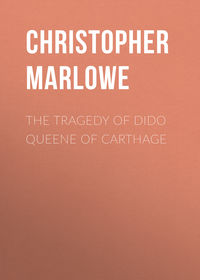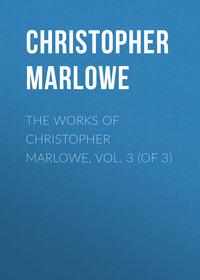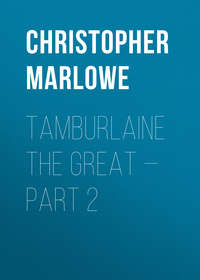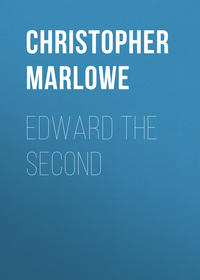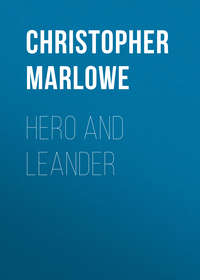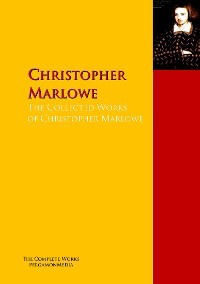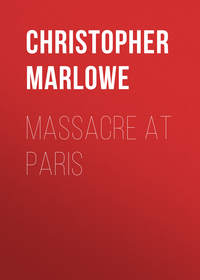 полная версия
полная версияThe Life and Death of Doctor Faustus Made into a Farce

Christopher Marlowe
The Life and Death of Doctor Faustus Made into a Farce
INTRODUCTION
According to "Some Account of the Life of Mr. W. Mountfort" prefixed to the collected plays of 1720, William Mountfort, successful playwright and actor, was born "the Son of Captain Mountfort, a Gentleman of a good Family in Staffordshire; and he spent the greatest Part of his Younger Years in that County, without being bred up to any Employment." Since "his Gaiety of Temper and Airy Disposition … could not be easily restrain'd to the solitary Amusements of a Rural Life,"1 he set out to make his fortune in London, and was employed by the Duke's Company at the Dorset Garden Theater. First notice of him appears in the part of the "boy" in The Counterfeits, attributed to John Leanerd, and produced in May, 1678.2
Mountfort was to win notice as an actor in the part of Talboy in Brome's The Jovial Crew, where as a rejected lover he was called upon for storms of comic tears. In his Apology, Cibber praises Mountfort in this part: "in his Youth, he had acted Low Humour, with great Success, even down to Tallboy in the Jovial Crew"3 and Mountfort himself alluded to his early success in the prologue to his first play, The Injured Lovers, where he defies the critics: "True Talboy to the last I'll Cry and Write."
Mountfort scored his first major success as an actor when he played the title role in Crowne's Sir Courtly Nice. The play's popularity owed much to Mountfort's acting of a part which recalls Etherege's Sir Fopling Flutter. The "Account" of 1720 says that Mountfort "gain'd a great and deserved Reputation, as a Player; particularly in Acting the part of Sir Courtly Nice," and Cibber, who was later to create the great Sir Novelty Fashion, says of Mountfort's Sir Courtly:
There his whole Man, Voice, Mien, and Gesture, was no longer Monfort, but another Person. There, the insipid, soft Civility, the elegant, and formal Mien; the drawling delicacy of Voice, the stately Flatness of his Address, and the empty Eminence of his Attitudes were … nicely observ'd.... If, some Years after the Death of Monfort, I my self had any Success, in either of these Characters, I must pay the Debt I owe to his Memory, in confessing the Advantages I receiv'd from the just Idea, and strong Impression he had given me, from his action them (Apology, p. 76).
In 1686, Mountfort married one of the attractive young actresses then appearing in London, Susanna Percival, and the Mountforts appeared together in a number of plays until his untimely death.
Mountfort brought his first play, The Injured Lovers: or, The Ambitious Father, a tragedy, to be acted at Drury Lane early in February, 1688. The play was not a great success. Gildon mentions that it "did not succeed as the Author wish'd,"4 although the play was brilliantly cast, with Betterton, Mrs. Bracegirdle, and Mrs. Barry in chief parts. Mountfort himself played second lead to Betterton, and the comedians Leigh, Jevon, and Underhill appeared in boisterous roles. But this rather extravagant account of passion and thwarted love did not take. Such lines as the heroine's "Thy Antelina, she shall be the Pile / On which I'll burn, and as I burn I'll smile," reveals an uncertain poetic talent. In the prologue Mountfort manages more wit:
JO. Hayne's Fate is now become my Share,For I'm a Poet, Marry'd, and a Player:The greatest of these Curses is the First;As for the latter Two, I know the worst …And of the play's fate:
Damn it who will, Damn me, I'll write again;Clap down each Thought, nay, more than I can think,Ruin my Family in Pen and Ink.And tho' my Heart should burst to see your Spite,True Talboy to the last, I'll Cry and Write....Unsuccessful at tragedy, Mountfort moved to surer ground, and if tragedy did not sell on the market of the 1680's, farce was surefire. Mountfort's The Life and Death of Doctor Faustus, Made into a Farce … with the Humours of Harlequin and Scaramouche, is a most interesting example of Restoration farce. The Queen's Theater in Dorset Garden was well-fitted for stage spectacle and effect, and Mountfort took advantage of his knowledge of the stage and the contemporary audience to produce an amusing and popular hit. The play was revived in 1697, five years after Mountfort's death, and again in 1724, at a time when, as Borgman tells us (p. 39), The Injured Lovers had been long forgotten.
Mountfort continued his acting career with great success; he was one of twenty-two men and six women who, on 12 January 1688, were given the position of "Comoedians in Ordinary" to King James, and he acted in a variety of plays, including Shadwell's The Squire of Alsatia, in May, 1688, and Bury Fair, in April, 1689. In Dryden's Don Sebastian, produced in December, 1689, he played the young and noble Don Antonio, described as "the wittiest Woman's toy in Portugal." Although Mountfort was best known for comic roles, he scored a success as Alexander in Nathaniel Lee's The Rival Queens, January, 1690. Cibber says of his Alexander:
In Tragedy he was the most affecting Lover within my Memory. His Addresses had a resistless Recommendation from the very Tone of his Voice … All this he particularly verify'd in that Scene of Alexander, where the Heroe throws himself at the Feet of Statira for Pardon of his past Infidelities. There we saw the Great, the Tender, the Penitent, the Despairing, the Transported, and the Amiable, in the highest Perfection (Apology, pp. 74-75).
Mountfort's third play was acted in January, 1690, although it may have been produced as early as December of the previous year. The Successful Strangers, a tragi-comedy, was based on a novel by Scarron, The Rival Brothers. In his Preface, Mountfort confesses, "I am no Scholar, which renders me incapable of stealing from Greek and Latin Authors, as the better Learned have done". The play was a success; its combination of comedy and tragedy appealed to the town, and it was revived several times in the early eighteenth century.
As Borgman notes (p. 80), Mountfort's acting career peaked in the season of 1690-1691, when he acted nine new roles, eight of which were leads. He also prepared a comedy of his own, Greenwich Park, and assisted in the writing or preparation of three other plays. He assisted Settle with Distress'd Innocence, and his name is linked with two plays by John Bancroft, Edward III and Henry the Second, although his contribution here, if any, is uncertain. The publishers of the collected plays of 1720 note that "we have annex'd, King Edward the Third, and Henry the Second; which tho' not wholly composed by him, it is presum'd he had, at least, a Share in fitting them for the Stage, otherwise it cannot be supposed he would have taken the Liberty of Writing Dedications to them." Borgman says of these plays that Mountfort "doubtless scanned the script with a critical eye and made such changes as would seem necessary to an experienced man of the theater" (p. 90).
In Greenwich Park, Mountfort scored his greatest success. The comedy is a hilarious mixture of the comedy of manners, humours, and farce. The prologue sounds the dominant motif of the play, that of satiric and energetic sex-intrigue: "At Greenwich lies the Scene, where many a Lass / Has bin Green-gown'd upon the tender Grass." The play hits wittily at fortune-hunters, cits, and old fellows who attempt to ignore their age. There is heavy reference to the contemporary London scene. The comedy was produced in April, 1691, with great success; Gildon says of it: "a very pretty Comedy, and has been always received with general Applause" (Lives and Characters, p. 102). The gay and witty Florella was played by Mrs. Mountfort—who played a part very much like that in which she was so successful previously, Sir Anthony Love. Mrs. Barry played the passionate Dorinda, a promiscuous and mercenary woman who, at one point in the play, cries out in the best tradition of sentimental comedy: "Oh what a Curse 'tis, when for filthy Gain / We affect a Pleasure in a real Pain." Sir Thomas Reveller, the heavy but comic father, was played by Leigh; Nokes and Underhill played comic cits, and Mountfort himself played opposite his wife as Young Reveller. The play was revived repeatedly, and remains a delightful work.
Mountfort's best part of his last year came in December, 1691, when he played the hilarious lout, Mr. Friendall, of Southerne's The Wives' Excuse. The play is good comedy, but quite serious, as Southerne focuses on the distress of an intelligent, sensitive woman, saddled with a foolish husband who is the perfect representative of a frivolous and malicious society. On Friday, 2 December 1692, Mountford acted what must have been his final role, Alexander in The Rival Queens.
Mountfort's life ended at the height of his fame, in the most spectacular and dramatic murder of its time. The notorious Lord Mohun, then age fifteen, frequented the playhouse in 1692, often in the company of Captain Richard Hill, age twenty. Hill hoped to win the affections of Anne Bracegirdle, known not only for her beauty and acting ability, but also for her chastity—supposedly a scarce virtue among the actresses of the time. In A Comparison between the Two Stages, the following dialogue takes place:
Sullen: But does that Romantick Virgin [Bracegirdle] still keep up her great Reputation?
Critick: D'ye mean her Reputation for Acting?
Sullen: I mean her Reputation for not acting; you understand me—....5
Hill, making no headway with Mrs. Bracegirdle, concluded that she was in fact interested in Mountfort; they had often appeared on the stage together. More than once Hill was heard to utter threats against the actor, although Mohun was apparently on friendly terms with Mountfort Hill, determined to abduct the actress, persuaded Mohun to be his accomplice. They set Friday, 9 December 1692, as the date, and about ten o'clock in the evening, accompanied by some soldiers under Hill's command, they ambushed Mrs. Bracegirdle, her mother and her brother, Hamlet Bracegirdle, along with a man named Page, in Drury Lane. The actress's mother and Mr. Page fended the villains off for a time, in a moment a crowd gathered, and the would-be kidnappers saw that their plan was useless. Hill escorted the actress home and after having muttered a threat at Mr. Page proceeded to pace up and down outside their door. Approximately an hour and a half later, Mountfort appeared in Howard Street—apparently intent on confronting Hill and Mohun. Mohun greeted the actor courteously and asked if he had been sent for. Mountfort professed that he did not know anything of the business at hand, that he had come there by chance, adding that Mrs. Bracegirdle was no concern of his. What happened then happened fast and the witnesses disagree (see Borgman, pp. 135ff). It would seem, however, that Hill first struck the actor, then quickly drew and ran him through before Mountfort could draw. On his deathbed, traditionally the locale for truth-telling, Mountfort reported that "My Lord Mohun offered me no Violence, but whilst I was talking with my Lord Mohun, Hill struck me with his Left Hand, and with his Right Hand run me through, before I could put my Hand to my Sword" (Borgman, p. 140). It would seem clear that Hill gave the actor his deathblow and then, while the cry of murder was raised, escaped into the night. Mountfort, fatally wounded, staggered toward his own home in the next street. As Mrs. Mountfort opened the door, her husband fell bleeding into her arms; at one o'clock in the afternoon of the next day, he died. According to the "Account," he was to have played Bussy D'Ambois that night—Marlowe's tragedy of a young man who meets his death through assassination.
Although Hill made good his escape, Lord Mohun stood trial in Westminster before his peers. Mohun's defense was simply that he was not privy to Hill's design and did not assist and encourage him in it. The lords, having heard the evidence, retired, and the next day, Saturday, 5 February, acquitted Mohun of wrongdoing by a vote of 69-14. The prisoner was discharged.
The United Company found themselves seriously hampered by the death of Mountfort, and even more so when fifteen days later the great comedian Anthony Leigh died. The "Account" says that Mountfort's death "had so great an Affect on his Dear Companion, Mr. LEE the Comedian, that he did not survive him above the space of a Week." The Company delayed the opening of a new play by one William Congreve, The Old Bachelor. But when that smash hit finally came on the boards in March 1693, Susanna Mountfort played the gay évaporée, Belinda, to great applause. And on 31 January 1694, she married the actor John Verbruggen. The rather mysterious Anne Bracegirdle, for whom Mountfort had been killed, played female leads in all of Congreve's plays, and just as the public had once speculated on her relationship to Mountfort, they now speculated on her relationship to Congreve.
Although farce was popular with London audiences during the Restoration, there was considerable controversy as to what it was and what it was worth. In a period in which the canon of English literary criticism was being formed, farce illustrates the disparity between received classical principles and the playwright's actual craft. Dryden, who himself "stooped" to writing farce, nonetheless sneers in his preface to An Evening's Love, or The Mock-Astrologer [1671]:
Farce … consists principally of grimaces … Comedy consists, though of low persons, yet of natural actions and characters; I mean such humours, adventures, and designs, as are to be found and met with in the world. Farce, on the other side, consists of forced humours, and unnatural events. Comedy presents us with the imperfections of human nature: Farce entertains us with what is monstrous and chimerical.6
Farce was theoretically unpopular because it relied on the extravagant and unnatural, as opposed to the play of real character found in comedy. And whereas in seventeenth-century comedy the avowed intention is usually to expose and thus to reform the vices and follies of the age, farce uses the grossly physical to draw a laugh; there is nothing to be learned from the slapstick and pigsbladder.
Though sneered at by theorists and subject to endless abuse in the prologues and epilogues of the day, farce continued as pleasing to Restoration audiences as it is today. James Sutherland notes that shrewd actor-playwrights such as Mountfort, Betterton, Underhill, Jevon, Dogget, Powell—men who knew intimately the tastes of the town, chose to write farce.7 Tate's A Duke and No Duke, Aphra Behn's The Emperor of the Moon, and Jevon's The Devil of a Wife, were among the most popular offerings, and although the Restoration wit may have gone to "Dr. Faustus" with a certain sense of intellectual slumming, he did continue to support quite generously the farceurs of that time. Moreover, farcical elements appear regularly in the supposedly elegant and artificial Restoration comedy of manners.
"Dr. Faustus" is a highly competent putting-together of those components which the experienced actor-playwright knew to be surefire. The date of its premier production is not known and has been assigned to a date as early as 1684 and as late as 1688. The farce was not published until the quarto of 1697, which appeared without cast-list, prologue, or epilogue.8 The title page, however, states that the farce was acted at Dorset Garden "several times," by "Lee" (Anthony Leigh) and Jevon, and, as the editor of The London Stage points out, since Jevon died in December of 1688, the premiere was probably no later than the season of 1687-1688.9 Borgman maintains that "Dr. Faustus" is Mountfort's second work, after The Injured Lovers of February, 1688, noting that the epilogue to that play, spoken by Jevon, suggests that Mountfort was planning, or had written, a farce:
Pardon but this, and I will pawn my life,His next shall match my Devil of a Wife,We'll grace it with the Imbellishment of Song and Dance;We'll have the Monsieur once again from France,With's Hoop and Glasses, and when that is done,He shall divert you with his Riggadoon.We might guess, then, that if the epilogue does refer to "Dr. Faustus," the date of that play is as late as the Spring of 1688.
Mountfort took as his raw material Marlowe's great tragedy and for that reason "Dr. Faustus" may be to some extent thought of as a burlesque. The Restoration audience delighted in Marlowe's Faustus; the Elizabethan tragedy had been played in 1662, and there was a performance at the Duke's Theater in September, 1675. Edward Phillips wrote in his Theatrum Poetarum, that "of all that [Marlowe] hath written to the Stage his Dr. Faustus hath made the greatest noise with its Devils and such like Tragical sport."10 Here lies the suggestion that Mountfort was to take up, for as Borgman notes, Marlowe's tragedy has two distinct lines: the mighty verse which makes up the tragedy of an heroic overreacher, and a comic line of farcical lazzi. Mountfort has trimmed away the poetry of Marlowe and, for the most part, retained the farcical elements of the earlier play.11
Mountfort keeps the compact with Mephostopholis, the appearance of good and bad angels, the visit of Lucifer and Beelzebub, the pageant of the seven deadly sins, the cheating of the horse-courser, the admonitions of the Old Man, the summoning of the spirits of Alexander and Darius, the tricking of Benvolio, the final moments of remorse before Faustus is dragged down to hell, and finally, the discovery of Faustus's limbs in his study. Mountfort's purpose, as Borgman notes, was not to convert an Elizabethan tragedy into a Restoration one, but to affix additional farcical materials to a work that already contained scenes of slapstick.
Mountfort's unique contribution to his source was the introduction of the commedia dell'arte figures which had become well-known to London theatergoers because of several visits to London by Italian actors since the Restoration. Probably, as Borgman notes (p. 36), the first Englishmen to play Scaramouche and Harlequin were Griffin and Haynes who had in 1677 appeared with the King's Company in Ravenscroft's Scaramouch a Philosopher, Harlequin a School-Boy, Bravo, Merchant, and Magician. When Aphra Behn's The Emperor of the Moon appeared in March, 1687, Leigh played Scaramouche and Harlequin was taken by Jevon. It seems probable that in order that these two actors might have a further opportunity to appear as these popular characters, a place was found for Scaramouche and Harlequin in Mountfort's farce.
The text of Mountfort's "Dr. Faustus" reveals that his farce, like any, must depend to a great extent on its farceurs. In Jevon and Leigh he had talented players and much of the script can be regarded merely as an improvisational chart allowing the two famed comics to maneuver. Jevon, as Leo Hughes points out, built up a considerable reputation, chiefly in low comedy roles since his first notice as Osric in a revival of Hamlet in 1673.12 Having a slight, thin figure, he was noted for his grace of movement and agility on the stage; he played Harlequin. Although Jevon could play such straight roles as Young Bellair in The Man of Mode, he, along with Nokes, Underhill, and Leigh, made his reputation in the boisterous farce of which "Dr. Faustus" is an excellent example.
Anthony Leigh played Scaramouche. Of his acting Cibber says:
In Humour, he lov'd to take a full Career, but was careful enough to stop short, when just upon the Precipice: He had great Variety, in his manner, and was famous in very different Characters.... But no wonder Leigh arriv'd to such Fame, in what was so completely written for him; when Characters that would make the Reader yawn, in the Closet, have by the Strength of his Action, been lifted into the lowdest Laughter, on the Stage (Apology, p. 85-86).
That Jevon and Leigh played well together is evident, and one can see great possibilities in their improvisation of such lazzi as the episode of the "dead body," Act I, Scene i, or in the elaborate show of compliment which ends the first act.
The presence of Scaramouche and Harlequin in Mountfort's adaptation suggests the influence of the Italian and French commedia on the Restoration stage, although, as Leo Hughes points out, the native tradition of farce is paramount (pp. 134-141). Hughes notes that although the commedia influence is obvious, Italian farce is different in style from the English, and that although there were four or five tours by commedia troops between 1660 and 1700, these visits were not enough to influence significantly English farce writing. Furthermore, the Italian's art was improvisational—they used no printed texts, and the English would therefore have even less chance to copy from the commedia. Readers of "Dr. Faustus" will find little trace of commedia influence apart from the conventional names. Hughes acknowledges (p. 141) the greater influence of the French stage in the Restoration, owing chiefly to the great popularity of Molière, whose influence on farce, especially on the afterpiece which became a staple on the English stage after 1695, was long-lived. His prestige was great; he appealed to English taste, and such characters as M. Jourdain, M. Pourceaugnac, and Sganarelle appear repeatedly in English adaptations.
The action of farce is typically a string of blow-ups, stage business highly dependent on fast pacing. Characteristically on the English stage there is a great deal of stage-effect; "Dr. Faustus," produced at the Dorset Garden Theater where farce was often produced in order to take advantage of the elaborate stage machinery available there, makes use of rising tables, a giant which divides in two, good and bad angels which rise and descend, fireworks, a vanishing feast, a view of hell, and even more. Indeed, the often hilarious stage directions give us good insight into the capabilities of the Restoration stage. The finale is typical: "Scene discovers Faustus's Limbs." After the Old Man piously hopes that this "May … a fair Example be to all, / To avoid such Ways which brought poor Faustus's Fall," the "Scene changes to Hell. Faustus Limbs come together. A Dance, and Song."
Farce often verges on satire, and, as he was to demonstrate in Greenwich Park, Mountfort had an eye for contemporary foibles. At the end of Act I, Harlequin and Scaramouche engage in dialogue which suggests similar passages of rough satire in Wycherley. Asked what practice his master, a doctor, has, Harlequin replies:
Why his Business is to patch up rotten Whores against the Term for Country Lawyers, and Attorneys Clerks; and against Christmas, Easter and Whitsun Holidays, for City Apprentices; and if his Pills [to cure clap] be destroy'd, 'twill ruin him in one Term.
Mountford altered the pageant of the seven sins that he found in Marlowe, changing it in at least one case to bring it up to date. He begins by paraphrasing Marlowe:
Faustus: What art thou the Third?
Envy: I am Envy; begot by a Chimny-sweeper upon an Oyster-wench. I cannot read, and wish all Books burnt.
But then Mountford departs from his source, adding the following lines:
I always curst the Governement, that I was not prefer'd; and was a Male-content in Three Kings Reigns (II, i).
The three kings are, I suppose, Charles I, Charles II, and James II, and the satiric jab is against those who perennially oppose the Establishment. Furthermore, it is easy to imagine that the role of Faustus, whoever played it, could well have been acted as a parody of the "tragical" acting style of the day, with its curious sing-song tone and stylized gestures.
Mountfort's "Dr. Faustus" gives us an often amusing insight into that much despised, ever-popular bastard-child of the Restoration stage: farce. If the direct influence of the commedia is slight, the spirit of improvisational comedy is embodied in the inspired buffoonery of Leigh and Jevon, reinforced by stage-effect and spots of contemporary satire. The play proved a hit and that undoubtedly was the playwright's sole intention. The farce is workmanlike, and as the "Account" prefixed to the 1720 collected plays observes, "THE Life and Death of Doctor FAUSTUS has a great deal of low, but Entertaining Humour; it sufficiently shews his Talents that way."


